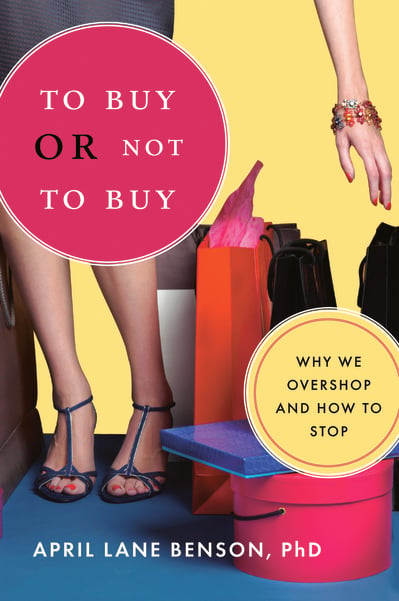
I recently had the pleasure of meeting the reknown psychologist, April Lane Benson, at a conference in Arizona, where we were both keynote speakers. April’s an expert in compulsive shopping. Afterwards, we had a chance to have lunch together and she gave me a copy of her new book, To Buy Or Not To Buy: Why We Overshop and How To Stop. It’s a great book that I highly recommend to anyone who’s ever shopped…shall we say, recreationally…which is most of us!
Here’s an interview with Dr. April Lane Benson:
Deborah: Based upon your experience April, why do you think people shop compulsively?
April: There are as many reasons to overshop as there are overshoppers. Each
one is a way of attempting to deal with thorny individual issues and
unmet personal needs; each is based on what real overshoppers
have told me over the years. Mostly, people shop to soothe themselves,
temporarily ease depression, overcome negative self image, or to avoid
dealing with something else. For some people, compulsive shopping is a
response to stress, lose, or trauma, and an attempt to feel more in
control. Sometimes people use compulsive shopping as a weapon, to
express anger or seek revenge. Or, some may shop to hold on to love,
as in the compulsive gift giver. Ultimately, compulsive buying is an
attempt to resolve a personal issue or spiritual dilemma.
Deborah: Why are women more prone to becoming “shopaholics?”
April: Actually, this is a misconception; shopping is not just a woman’s
thing. Studies show that men and women were almost equally likely to be
compulsive buyers. They do shop differently, however. Men tend to shop
more in a “work” frame and women are more “leisure” shoppers. Women–who
tend to be other-oriented and relationship-centered–tend to buy
clothing, jewelry, cosmetics, and appearance oriented goods. While
men–who tend to be self-oriented and activity-centered–often purchase electronics and sports equipment, primarily functional goods.
Men and women also relate differently to what they have…women value
their emotional and symbolic possessions, while men favor their functional
and leisure items.
Also, men’s shopping is more culturally acceptable. We tend to see men
more as consumers and collectors, but not shoppers. While women’s
shopping habits are often seen as self-indulgent and unimportant. Call
it what you will, the fact is that both genders are subject to serious
abuses when it comes to buying behavior.
Deborah: What tips can you recommend to our readers who consistently overshop or spend beyond their means?
Here’s April’s Tips:
1. Be a private eye around your buying behavior. Identify the cues or
triggers that lead to overshopping or overspending, e.g. a bad day at
work, a fight with a spouse, feeling lonely, bored, or in need of
reward, free time, or the holidays perhaps. Look for patterns and
connections. It’s important to realize that shopping is an equal
opportunity, all purpose mood changer, but works only temporarily.
After a short while, your mood will often dip even below where it was
before you shopped because now the guilt and the remorse are added to
it.
2. Look at the consequences of your overshopping. In what areas of
your life is it costing you? Financially? Emotionally? Socially?
Occupationally? Spiritually?
3. Choose someone in your life to be a Shopping Support Buddy and
brainstorm together about how that person will support you to stop
overshopping.
4. Expect that you may very likely feel worse before you feel better,
since the anesthetic qualities that the buying supplied are now gone.
5. Write down everything you spend and assign each expenditure a score,
based on how necessary you deem it to be, from 0=entirely unnecessary,
to 1/3=a little necessary, to 2/3=very necessary to 1, essential. At
the end of the week, look at how many of your purchases you rated
entirely or relatively unnecessary and then you’ll see how much you
could save if you were only buying things that were more necessary
rather than less.
6. Make sure you allocate some money each month for Heartsongs, things
that make your heart sing. Otherwise, you’re putting yourself at risk
for feelings of deprivation and a spending binge.
7, Consult one of the many online calculators that will help you to see the high cost of credit card debt.
8. Take control of your cues by avoiding them altogether, or limiting
your exposure . If Bloomingdales is a cue…stay far away!
9. Also build in a pause between your impulse to buy and your actual buying behavior. During the pause, ask yourself:
a. Why am I here?
b. How do I feel?
c. Do I need this?
d. What if I wait?
e. How will I pay for it?
f. Where will I put it?
10. Use cash or a debit card, without overdraft protection. Know what’s in your checking account at all times.
11. Make a list of your best reasons to stop overshopping. Keep this “Why Not Shop?” list with you at all times.
12. Ask yourself: What Am I Really Shopping For?. What underlying
emotional needs have triggered my impulse to overshop? Instead of
shopping,do something else that is healthy and life-enhancing to meet some of your underlying needs. If you shop because you’re lonely, find
another way to feel connected that builds self-esteem, not tears it
down!
Remember: You can never get enough of what you don’t really need.
Thank you, April…those are very wise words.
Peace and Blessings!

